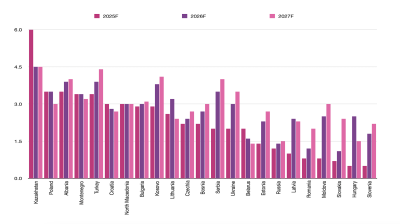Risk analysis identifies Turkey, Iran and Russia among 37 nations likely to face mass ‘post-Covid’ protests

Turkey, Iran and Russia are among 37 emerging and frontier market countries likely to face mass protests in the coming months as restrictions imposed to control the coronavirus (COVID-19) pandemic are increasingly lifted and the huge economic impact of the crisis is realised, according to new research from a global risk analysis company.
“The total number of protests in frontier and emerging markets has almost rebounded to pre-pandemic levels,” said Verisk Maplecroft principal analyst Miha Hribernik. “With many countries still in lockdown, and the full economic shock of the outbreak yet to be felt, we expect the number of protests to surge over the next 2-3 months.”
37 countries with high pre-existing levels of unrest and poor pandemic recovery capacity are said to face a 'perfect storm' of instability over the next 2-3 years.
Verisk Maplecroft concluded that the outlook was particularly worrying for frontier and emerging markets where the post-pandemic economic outlook is bleak. Iran, Nigeria, Bangladesh, Algeria and Ethiopia are among countries facing a “perfect storm” of grassroots anger—protests triggered by the pandemic’s economic fallout look set to combine with unrest over pre-existing grievances over issues ranging from poverty to food supply, it said.
“Our base case from January—that 2020 will see a surge in protests and that the coming decade is set to be one of unprecedented unrest—still stands,” said Hribernik. “But in the countries least prepared to bounce back from the pandemic, it now looks like a best-case scenario.”
Russia, Turkey, India, Brazil, South Africa and Indonesia face risks that are only slightly less acute than those of the countries with the most “perfect storm” potential, the report added.
Belarus, Bulgaria and Serbia, as well as Congo and Ethiopia, are among countries to have been shaken by anti-government protests in recent days.
There was a drop-off in unrest in emerging and frontier markets in March, according to Armed Conflict Location & Event Data (ACLED), after the widespread introduction of lockdowns. But with the International Monetary Fund (IMF) forecasting that growth in emerging markets and developing economies will contract by 1% this year, certain simmering pots of tension may come to the boil.
Hribernik used five factors to determine the ability of 142 countries to bounce back from the pandemic. That was combined with data from past protests to determine projections of civil unrest. “It’s a tinderbox” Hribernik said. “It doesn’t take as much as it did a year ago.”
In 2019, Verisk Maplecroft recorded 47 countries with a significant uptick in demonstrations, including Hong Kong, Chile, Nigeria, Sudan and Haiti. It anticipated more turmoil in 2020. “It was very much a global phenomenon last year” said Hribernik. “Each protest was unique, primality driven by anger over inequality, corruption, erosion of trust of political elites. These are not issues that can be resolved overnight. They are structural issues that take years or decades to address.”
Features
Ukraine gets a B grade from EU: good, but more work needed
President Volodymyr Zelenskiy rejected a two-tier solution proposed by Brussels to accelerate Ukraine’s EU accession bid, after the European Commission (EC) released a progress report on November 4.

Indonesia faces fiscal dilemma over $7.27bn high-speed rail debt
The operator, PT Kereta Cepat Indonesia - China, now faces mounting pressure to service both principal and interest payments.

Kazakhstan defies global FDI downturn as investors target new sectors
Renewables, agribusiness, data centres and advanced manufacturing among new magnets for investment sitting alongside oil, gas and mining.
_1762193126.jpg)
Is Venezuela's resource wealth Trump's real target?
As US military forces mass in the Caribbean, Venezuela's oil and mineral wealth emerges as a potential prize in a looming confrontation that will likely result in the ousting of President Nicolas Maduro.




